
|
Now it is bright as 8.8 mag (Sept. 25, Chris Wyatt). It is observable at 8 mag for a long time from 2022 to 2023. In the Southern Hemisphere, it stays observable for a long time, although it becomes low temporarily from November to December. In the Northern Hemisphere, it is not observable until 2023 summer.
Date(TT) R.A. (2000) Decl. Delta r Elong. m1 Best Time(A, h)
Oct. 8 16 1.29 -35 2.0 2.471 2.021 52 8.3 18:58 ( 46, 0)
Oct. 15 16 5.75 -37 15.7 2.514 1.982 47 8.2 18:49 ( 46, -4)
|
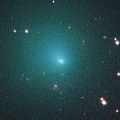
|
Now it is very bright as 10.7 mag (Oct. 2, Marco Goiato). It stays 10 mag until November. In the Northern Hemisphere, it becomes unobservable soon. In the Southern Hemisphere, it becomes unobservable temporarily from December to January.
Date(TT) R.A. (2000) Decl. Delta r Elong. m1 Best Time(A, h)
Oct. 8 22 26.85 -39 34.0 0.962 1.728 123 10.0 21:15 ( 0, 15)
Oct. 15 21 34.90 -41 52.8 1.092 1.696 108 10.1 19:57 ( 0, 13)
|
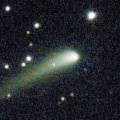
|
Now it is bright as 11.6 mag (Oct. 2, Osamu Miyazaki). It will approach to Earth down to 0.29 a.u. in 2023 February, and it is expected to brighten up to 5 mag. In the Northern Hemisphere, it stays observable in excellent condition. In the Southern Hemisphere, it is not observable until early February.
Date(TT) R.A. (2000) Decl. Delta r Elong. m1 Best Time(A, h)
Oct. 8 15 53.45 27 0.9 2.253 1.860 54 11.5 18:58 (100, 36)
Oct. 15 15 51.41 26 12.7 2.238 1.782 50 11.3 18:49 (102, 32)
|
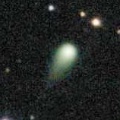
|
Now it is 12.0 mag (Oct. 3, Osamu Miyazaki). It is expected to brighten up to 10 mag in 2023. In the Northern Hemisphere, it stays observable in good condition until 2023 autumn, although it became very low temporarily in summer. In the Southern Hemipshere, it stays unobservable until 2023 summer.
Date(TT) R.A. (2000) Decl. Delta r Elong. m1 Best Time(A, h)
Oct. 8 10 50.59 55 21.8 3.518 3.244 66 11.8 4:36 (223, 35)
Oct. 15 10 55.64 56 31.4 3.370 3.191 71 11.7 4:41 (222, 39)
|
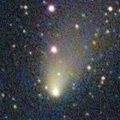
|
It brightened up to 10.4 mag from June to July (July 22, Ken-ichi Kadota). Appearing in the morning sky in the Souther Hemisphere. It will never be observable again in the Northern Hemisphere.
Date(TT) R.A. (2000) Decl. Delta r Elong. m1 Best Time(A, h)
Oct. 8 12 40.08 -36 48.3 2.312 1.548 31 11.8 4:36 (296,-31)
Oct. 15 12 59.42 -40 53.0 2.369 1.624 32 12.1 4:41 (301,-30)
|

|
It brightened up to 8.3 mag in last winter (Jan. 6, Toshiyuki Takahashi). Now it is fading. But it is bright as 11.0 mag still now (Sept. 30, Thomas Lehmann).
Date(TT) R.A. (2000) Decl. Delta r Elong. m1 Best Time(A, h)
Oct. 8 9 37.14 -12 54.5 4.900 4.308 48 12.0 4:36 (299, 16)
Oct. 15 9 41.87 -14 24.5 4.863 4.343 53 12.1 4:41 (306, 20)
|
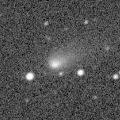
|
Now it is 12.1 mag (Oct. 3, Ken-ichi Kadota). It will appear in the morning sky in November also in the Southern Hemisphere. It stays 11-12 mag until spring.
Date(TT) R.A. (2000) Decl. Delta r Elong. m1 Best Time(A, h)
Oct. 8 10 39.92 8 32.8 2.440 1.735 36 12.2 4:36 (272, 17)
Oct. 15 10 58.46 6 49.6 2.380 1.710 38 12.1 4:41 (275, 19)
|
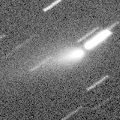
|
Now it is 12.6 mag (Sept. 19, Chris Wyatt). It stays 11-12 mag to autumn. It stays observable in good condition in the Southern Hemisphere. It locates low in the Northern Hemisphere. Michael Jager detected several fragments at 17.5-19 mag.
Date(TT) R.A. (2000) Decl. Delta r Elong. m1 Best Time(A, h)
Oct. 8 17 31.25 -35 28.9 1.000 1.148 70 12.4 18:58 ( 31, 11)
Oct. 15 18 15.16 -36 5.4 1.038 1.201 72 12.8 18:49 ( 26, 13)
|

|
Now it is bright as 12.8 mag (Aug. 28, Hiroshi Abe). It stays 12 mag for a while. It becomes unobservable from August to November in the Northern Hemisphere, or from September to December in the Southern Hemisphere.
Date(TT) R.A. (2000) Decl. Delta r Elong. m1 Best Time(A, h)
Oct. 8 13 37.91 -3 4.0 5.334 4.360 11 12.6 18:58 ( 91, -7)
Oct. 15 13 45.62 -3 5.2 5.357 4.374 8 12.7 18:49 ( 93,-10)
|
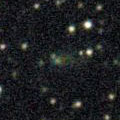
|
Now it is 14.7 mag (Sept. 29, Katsumi Yoshimoto). It is expected to brighten very rapidly up to 11-12 mag in winter, and it will be observable in excellent condition.
Date(TT) R.A. (2000) Decl. Delta r Elong. m1 Best Time(A, h)
Oct. 8 7 10.42 11 42.6 1.639 1.873 86 12.9 4:36 (313, 59)
Oct. 15 7 24.06 11 6.3 1.566 1.861 90 12.7 4:41 (322, 61)
|

|
It brightened up to 9.3 mag in early summer (June 5, Chris Wyatt). Now it is fading. It has already faded down to 15.1 mag (Oct. 6, ATLAS Chile). In the Southen Hemisphere, it stays observable in good condition for a long time. In the Northern Hemisphere, it will be observable after November.
Date(TT) R.A. (2000) Decl. Delta r Elong. m1 Best Time(A, h)
Oct. 8 10 13.83 -39 37.3 2.841 2.317 49 12.7 4:36 (314, -8)
Oct. 15 10 13.82 -40 1.9 2.853 2.371 51 12.8 4:41 (318, -3)
|

|
The condition is worst in this apparition. It is not observable at all.
Date(TT) R.A. (2000) Decl. Delta r Elong. m1 Best Time(A, h)
Oct. 8 14 12.60 -7 55.9 1.988 1.102 19 12.9 18:58 ( 82, -3)
Oct. 15 14 41.19 -10 16.7 2.013 1.133 20 13.3 18:49 ( 79, -2)
|

|
Now it is 13.1 mag (Oct. 2, Toshihiko Ikemura, Hirohisa Sato). It is expected to brighten up to 11 mag in 2023. In the Northern Hemisphere, it stays observable in good condition until November. But it becomes unobservable after that. In the Southern Hemisphere, it stays observable in good condition for a long time, although it becomes unobservable temporarily from November to January.
Date(TT) R.A. (2000) Decl. Delta r Elong. m1 Best Time(A, h)
Oct. 8 17 18.91 -9 37.7 3.991 3.697 65 13.3 18:58 ( 49, 30)
Oct. 15 17 21.65 -11 10.5 4.060 3.661 59 13.2 18:49 ( 52, 27)
|
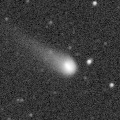
|
Now it is 13.7 mag (Sept. 24, Hiroshi Abe). It is expected to brighten up to 12 mag in 2023. In the Northern Hemisphere, it stays observable in good condition for a long time, although it becomes unobservable temporarily in October. In the Southern Hemisphere, it is not observable until mid December. But it will be observable in good condition in 2023.
Date(TT) R.A. (2000) Decl. Delta r Elong. m1 Best Time(A, h)
Oct. 8 13 34.45 14 54.6 4.843 3.943 23 13.5 18:58 (106, 2)
Oct. 15 13 36.77 13 43.2 4.821 3.919 22 13.4 18:49 (108, -2)
|
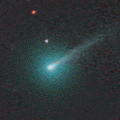
|
Bright new comet. Now it is bright as 12.4 mag (Oct. 2, Michael Jager). Although it is a tiny comet, it will approach to Sun down to 0.63 a.u. on Oct. 25. In the Northern Hemisphere, it is observable until late October. In the Southern Hemisphere, it is not observable after this.
Date(TT) R.A. (2000) Decl. Delta r Elong. m1 Best Time(A, h)
Oct. 8 11 2.14 26 48.6 1.034 0.732 42 13.7 4:36 (252, 23)
Oct. 15 12 4.61 24 4.2 1.090 0.670 37 13.4 4:41 (251, 16)
|

|
Now it is 13.6 mag (Sept. 30. Hiroshi Abe).
Date(TT) R.A. (2000) Decl. Delta r Elong. m1 Best Time(A, h)
Oct. 8 6 56.39 28 57.4 5.913 6.031 91 13.7 4:36 (285, 73)
Oct. 15 6 57.95 28 58.8 5.804 6.033 98 13.7 4:41 (300, 79)
|

|
Now it is 15.2 mag (Sept. 28, D. Buczynski). It is expected to brighten up to 12 mag from winter to summer in 2023. In the Northern Hemisphere, it stays observable in good condition until 2023 spring. In the Southern Hemisphere, it stays observable in good condition for a long time after this. It is fainter than this ephemeris recently.
Date(TT) R.A. (2000) Decl. Delta r Elong. m1 Best Time(A, h)
Oct. 8 5 16.12 30 40.2 2.577 3.116 113 14.0 4:11 ( 0, 86)
Oct. 15 5 13.81 29 10.1 2.421 3.059 121 13.8 3:42 ( 0, 84)
|

|
Now it is 13.7 mag (Sept. 17, Thomas Lehmann). It stays observable at 13-14 mag for a while.
Date(TT) R.A. (2000) Decl. Delta r Elong. m1 Best Time(A, h)
Oct. 8 18 53.00 -30 53.8 2.958 3.074 87 14.1 18:58 ( 17, 22)
Oct. 15 19 0.63 -30 35.2 3.057 3.079 81 14.2 18:49 ( 19, 22)
|
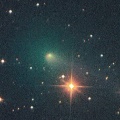
|
Now it is 14.2 mag (Sept. 25, Chris Wyatt). It stays observable in good condition after this. But it will be fading gradually after this.
Date(TT) R.A. (2000) Decl. Delta r Elong. m1 Best Time(A, h)
Oct. 8 1 12.30 -0 40.9 1.452 2.446 172 14.3 0:08 ( 0, 54)
Oct. 15 1 5.90 -1 16.9 1.501 2.489 169 14.5 23:30 ( 0, 54)
|

|
Now it is 15.0 mag (Oct. 2, Ken-ichi Kadota). The brightness evolution is slower than originally expected. It stays 14-15 mag for a long time. It locates extremely low in the Northern Hemisphere. In the Southern Hemisphere, it will be unobservable temporarily in November.
Date(TT) R.A. (2000) Decl. Delta r Elong. m1 Best Time(A, h)
Oct. 8 16 47.57 -27 25.7 3.340 2.964 59 14.5 18:58 ( 44, 12)
Oct. 15 16 50.88 -25 51.9 3.457 2.970 53 14.5 18:49 ( 47, 11)
|

|
Now it is 13.8 mag (Aug. 20, Chris Wyatt). It will be fading after this. Now it is not observable. It will be observable agin at 16 mag in January in the Southern Hemisphere, or in February in the Northern Hemisphere.
Date(TT) R.A. (2000) Decl. Delta r Elong. m1 Best Time(A, h)
Oct. 8 14 7.05 -13 52.9 3.186 2.273 19 14.9 18:58 ( 78, -8)
Oct. 15 14 21.39 -15 11.7 3.222 2.286 16 15.0 18:49 ( 78, -9)
|
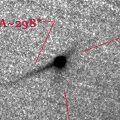
|
Due to the DART spacecraft impact to its satellite Dimorphos on Sept. 26, the cometary activity was detected. Now it is bright as 12.9 mag (Sept. 28, John Drummond). It stays bright and observable in good condition until mid January
Date(TT) R.A. (2000) Decl. Delta r Elong. m1 Best Time(A, h)
Oct. 8 5 27.86 -21 12.3 0.072 1.023 107 15.1 4:21 ( 0, 34)
Oct. 15 6 26.17 -11 23.9 0.079 1.015 101 15.4 4:41 (356, 43)
|
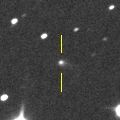
|
Now it is 16.7 mag (Oct. 6, A. Diepvens). It will brighten up to 14 mag in early 2023, and it will be observable in good condition. It is fainter than this ephemeris recently.
Date(TT) R.A. (2000) Decl. Delta r Elong. m1 Best Time(A, h)
Oct. 8 8 36.02 16 36.1 3.828 3.564 67 15.2 4:36 (284, 47)
Oct. 15 8 44.10 16 31.9 3.716 3.543 72 15.1 4:41 (289, 52)
|

|
Now it is 15.1 mag (Sept. 28, ATLAS South Africa). It was expected to brighten up to 13 mag in spring. But actually, it was fainter than originally expected. In the Southern Hemisphere, it stays observable in good condition for a long time. In the Northern Hemisphere, it stays extremely low for a while.
Date(TT) R.A. (2000) Decl. Delta r Elong. m1 Best Time(A, h)
Oct. 8 6 7.27 -50 18.3 3.111 3.315 92 15.2 4:36 (356, 5)
Oct. 15 5 52.87 -51 34.9 3.075 3.337 96 15.2 4:20 ( 0, 3)
|
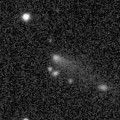
|
Now it is 15.3 mag (Sept. 27, Michael Jager). It stays 15 mag and observable in excellent condition until December.
Date(TT) R.A. (2000) Decl. Delta r Elong. m1 Best Time(A, h)
Oct. 8 2 46.09 17 53.5 1.511 2.427 149 15.2 1:42 ( 0, 73)
Oct. 15 2 41.51 19 4.0 1.473 2.423 157 15.2 1:10 ( 0, 74)
|
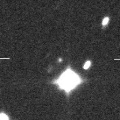
|
It is expected to brighten up to 12.5 mag in winter. In the Northern Hemisphere, it will become observable in October. Then it stays observable in good condition after that. In the Southern Hemisphere, it is not observable until 2023 June.
Date(TT) R.A. (2000) Decl. Delta r Elong. m1 Best Time(A, h)
Oct. 8 12 1.91 18 6.0 3.266 2.418 26 15.4 4:36 (252, 6)
Oct. 15 12 11.46 18 59.4 3.147 2.360 31 15.2 4:41 (255, 11)
|
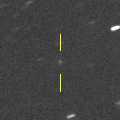
|
It will brighten up to 13 mag in winter. But the condition is bad. It is not observable until February in the Southern Hemisphere, or until May in the Northern Hemisphere.
Date(TT) R.A. (2000) Decl. Delta r Elong. m1 Best Time(A, h)
Oct. 8 13 39.07 -7 9.1 2.842 1.873 11 15.6 18:58 ( 88, -9)
Oct. 15 13 55.01 -8 59.9 2.820 1.841 8 15.4 18:49 ( 86,-11)
|

|
Now it is 15.1 mag (Sept. 30, Hiroshi Abe). It stays observable in good condition at 15 mag from summer to winter. It locates somwwhat low in the Southern Hemisphere.
Date(TT) R.A. (2000) Decl. Delta r Elong. m1 Best Time(A, h)
Oct. 8 7 25.63 19 21.8 2.242 2.361 84 15.5 4:36 (297, 62)
Oct. 15 7 34.87 19 13.6 2.168 2.370 88 15.4 4:41 (306, 66)
|
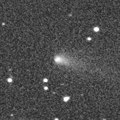
|
Now it is 15.1 mag (Sept. 30, Ken-ichi Kadota). It stays 15.5 mag until November, and it stays observable in good condition.
Date(TT) R.A. (2000) Decl. Delta r Elong. m1 Best Time(A, h)
Oct. 8 1 31.46 2 31.6 1.138 2.129 169 15.6 0:27 ( 0, 58)
Oct. 15 1 27.94 1 42.3 1.134 2.127 173 15.5 23:52 ( 0, 57)
|
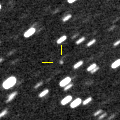
|
Now it is 15.1 mag (Oct. 6, ATLAS-MLO, Mauna Loa). It will brighten up to 14 mag in 2023. In the Southern Hemisphere, it stays observable in good condition for a long time. It locates somewhat low in the Northern Hemisphere.
Date(TT) R.A. (2000) Decl. Delta r Elong. m1 Best Time(A, h)
Oct. 8 6 29.22 -17 19.3 3.699 3.898 93 15.7 4:36 (346, 36)
Oct. 15 6 22.99 -18 27.4 3.556 3.863 100 15.6 4:41 (357, 37)
|
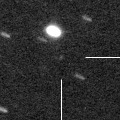
|
Now it is 15.4 mag (Sept. 24, X. Gao, Q.-Z. Ye). It is expected to brighten up to 8 mag in 2023 July. In 2022, it stays observable in good condition while the comet will be brightening gradually.
Date(TT) R.A. (2000) Decl. Delta r Elong. m1 Best Time(A, h)
Oct. 8 2 54.60 -1 48.0 3.051 3.939 148 15.9 1:50 ( 0, 53)
Oct. 15 2 43.85 -3 18.8 2.940 3.871 155 15.7 1:12 ( 0, 52)
|
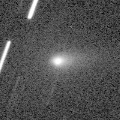
|
Now it is 14.0 mag (Sept. 22, Michael Jager). It brightened rapidly as predicted. It will be fading after this, and it will be fainter than 18 mag in December.
Date(TT) R.A. (2000) Decl. Delta r Elong. m1 Best Time(A, h)
Oct. 8 2 16.97 -27 37.7 0.693 1.599 141 15.8 1:12 ( 0, 28)
Oct. 15 2 17.62 -32 0.7 0.735 1.617 137 16.0 0:45 ( 0, 23)
|

|
Now it is 15.8 mag (Oct. 2, Toshihiko Ikemura, Hirohisa Sato). Now it is fading. It stays 13-14 mag for a while. It is observable in excellent condition in the Southern Hemisphere. It locates somewhat low in the Northern Hemisphere.
Date(TT) R.A. (2000) Decl. Delta r Elong. m1 Best Time(A, h)
Oct. 8 22 17.02 -26 59.9 1.696 2.462 130 16.0 21:09 ( 0, 28)
Oct. 15 22 17.05 -26 12.2 1.803 2.502 124 16.2 20:42 ( 0, 29)
|

|
Now it is 17.1 mag (Sept. 30, J.-C. Merlin). It stays at 15-16 mag for a long time. In the Southern Hemisphere, it stays observable in excellent condition for a long time, although it becomes extremely low temporarily in November. In the Northern Hemiphere, it is not observable after this.
Date(TT) R.A. (2000) Decl. Delta r Elong. m1 Best Time(A, h)
Oct. 8 14 32.65 -50 3.4 6.225 5.622 49 16.0 18:58 ( 43,-22)
Oct. 15 14 35.87 -50 30.1 6.305 5.646 45 16.0 18:49 ( 44,-25)
|
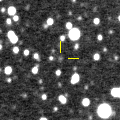
|
Now it is 16.6 mag (Oct. 1, ATLAS Chile). It will brighten up to 13 mag from 2024 to 2025.
Date(TT) R.A. (2000) Decl. Delta r Elong. m1 Best Time(A, h)
Oct. 8 8 57.02 -29 41.2 7.651 7.209 60 16.1 4:36 (318, 10)
Oct. 15 9 0.57 -30 25.8 7.557 7.174 63 16.0 4:41 (324, 14)
|
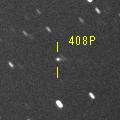
|
Now it is 16.6 mag (Sept. 26, ATLAS-HKO, Haleakala). It will be observable at 16-17 mag in excellent condition from autumn to winter.
Date(TT) R.A. (2000) Decl. Delta r Elong. m1 Best Time(A, h)
Oct. 8 4 38.59 4 33.3 2.810 3.468 123 16.2 3:34 ( 0, 60)
Oct. 15 4 38.43 3 43.0 2.740 3.468 130 16.2 3:06 ( 0, 59)
|
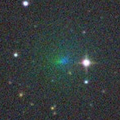
|
Brightened rapidly. It brightened up to 14.0 mag in early September (Sept. 2, Michael Jager). Now it is 16.0 mag (Sept. 26, Ken-ichi Kadota). It will be fading after this. In the Northern Hemisphere, it stays observable for a long time, although it becomes extremely low in November. It is not observable after this in the Southern Hemisphere.
Date(TT) R.A. (2000) Decl. Delta r Elong. m1 Best Time(A, h)
Oct. 8 15 18.58 17 9.1 2.182 1.597 42 16.3 18:58 ( 94, 24)
Oct. 15 15 17.47 17 30.3 2.254 1.608 39 16.4 18:49 ( 97, 21)
|

|
Now it is 16.1 mag (Sept. 23, Michael Jager). It stays observable at 16 mag from summer to winter. It will be getting higher after this also in the Southern Hemisphere. Michael Jager discovered a 18-mag fragment.
Date(TT) R.A. (2000) Decl. Delta r Elong. m1 Best Time(A, h)
Oct. 8 9 4.99 18 10.4 1.821 1.598 61 16.3 4:36 (277, 42)
Oct. 15 9 22.05 16 5.9 1.789 1.612 63 16.3 4:41 (282, 44)
|

|
Now it is 16.2 mag (Oct. 6, ATLAS Chile). It is expected to brighten up to 7 mag in early 2024. In the Southern Hemisphere, it stays observable in good condition for a long time. In the Northern Hemisphere, it stays low in 2022.
Date(TT) R.A. (2000) Decl. Delta r Elong. m1 Best Time(A, h)
Oct. 8 6 20.59 -28 29.1 5.685 5.846 94 16.4 4:36 (350, 26)
Oct. 15 6 21.08 -29 36.1 5.557 5.784 98 16.3 4:41 (358, 25)
|
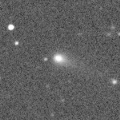
|
Now it is 15.8 mag (Sept. 28, Michael Jager). It continued brightening even after the perihelion passage. It stays observable at 16 mag in good condition for a while.
Date(TT) R.A. (2000) Decl. Delta r Elong. m1 Best Time(A, h)
Oct. 8 23 0.66 -2 48.2 3.420 4.319 150 16.6 21:53 ( 0, 52)
Oct. 15 22 58.77 -3 6.2 3.491 4.331 143 16.6 21:23 ( 0, 52)
|

|
It brightened up to 14 mag in 2021. Now it is fading. It has already faded down to 15.9 mag (Oct. 3, ATLAS Chile). It is observable at 16-17 mag in 2022.
Date(TT) R.A. (2000) Decl. Delta r Elong. m1 Best Time(A, h)
Oct. 8 23 31.77 15 15.3 5.298 6.235 157 16.6 22:23 ( 0, 70)
Oct. 15 23 28.12 15 13.2 5.374 6.273 152 16.6 21:52 ( 0, 70)
|
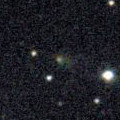
|
Now it is 16.9 mag (Oct. 1, Toshihiko Ikemura, Hirohisa Sato). It will be observable at 16-17 mag in good condition from summer to autumn.
Date(TT) R.A. (2000) Decl. Delta r Elong. m1 Best Time(A, h)
Oct. 8 3 40.74 27 42.3 1.651 2.458 134 16.6 2:36 ( 0, 83)
Oct. 15 3 37.97 27 39.2 1.621 2.483 141 16.6 2:06 ( 0, 83)
|

|
Now it is 15.7 mag (Sept. 30, J. L. Virlichie, P. Traverse, H. Roy, G. Houdin). It brightened up to 14 mag from 2020 to 2021. Now it is fading slowly. It is observable at 16-17 mag in 2022.
Date(TT) R.A. (2000) Decl. Delta r Elong. m1 Best Time(A, h)
Oct. 8 0 21.66 -20 2.6 3.078 3.995 153 16.7 23:13 ( 0, 35)
Oct. 15 0 17.31 -20 7.8 3.133 4.012 147 16.7 22:41 ( 0, 35)
|

|
It brightened up to 14.2 mag in 2021 summer (July 18, 2021, Taras Prystavski). Now it is fading. It has already faded down to 16.7 mag (Oct. 6, ATLAS Chile). In the Southern Hemisphere, it stays observable in good condition for a long time. It locates somewhat low in the Northern Hemisphere.
Date(TT) R.A. (2000) Decl. Delta r Elong. m1 Best Time(A, h)
Oct. 8 1 52.48 -26 58.3 4.615 5.458 144 17.0 0:48 ( 0, 28)
Oct. 15 1 47.22 -26 48.1 4.661 5.501 144 17.0 0:15 ( 0, 28)
|

|
Now it is 17.1 mag (Oct. 2, Toshihiko Ikemura, Hirohisa Sato). It stayed bright for a while even after the perihelion passage, but it will be fading after this. It will be fainter than 18 mag in winter.
Date(TT) R.A. (2000) Decl. Delta r Elong. m1 Best Time(A, h)
Oct. 8 21 19.39 2 29.4 6.551 7.192 126 17.0 20:12 ( 0, 58)
Oct. 15 21 17.17 1 35.0 6.675 7.219 119 17.1 19:42 ( 0, 57)
|
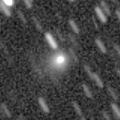
|
It brightened by 6 mag in outburst up to 14.6 mag (Aug. 13, ATLAS-MLO, Mauna Loa). Now it is fading. But it is bright as 16.1 mag still now (Oct. 1, Toshihiko Ikemura, Hirohisa Sato). It stays observable in good condition for a while.
Date(TT) R.A. (2000) Decl. Delta r Elong. m1 Best Time(A, h)
Oct. 8 18 58.10 -0 11.5 1.683 1.976 91 17.0 18:58 ( 28, 51)
Oct. 15 19 8.97 -1 43.5 1.715 1.943 87 17.3 18:49 ( 29, 49)
|
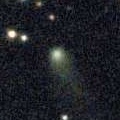
|
Now it is 16.6 mag (Oct. 2, Toshihiko Ikemura, Hirohisa Sato). It stays observable at 16 mag from 2021 to 2022. It locates low in the Southern Hemisphere.
Date(TT) R.A. (2000) Decl. Delta r Elong. m1 Best Time(A, h)
Oct. 8 15 58.34 38 8.7 5.938 5.529 61 17.1 18:58 (113, 41)
Oct. 15 16 4.54 37 55.2 5.984 5.557 60 17.1 18:49 (113, 39)
|

|
Now it is 16.1 mag (Sept. 30, D. Buczynski). Fading slowly. In the Northern Hemisphere, it stays observable in good condition for a long time. In the Southern Hemisphere, it is not observable after this.
Date(TT) R.A. (2000) Decl. Delta r Elong. m1 Best Time(A, h)
Oct. 8 17 9.54 64 11.0 9.477 9.430 84 17.1 18:58 (151, 51)
Oct. 15 17 10.98 63 48.0 9.493 9.444 84 17.1 18:49 (150, 49)
|
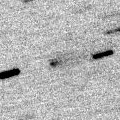
|
Now it is 18.0 mag (Oct. 2, M. Jaeger, E. Prosperi, S. Prosperi). It stays observable at 17 mag until winter. In the Southern Hemisphere, it locates extremely low until autumn.
Date(TT) R.A. (2000) Decl. Delta r Elong. m1 Best Time(A, h)
Oct. 8 8 54.82 18 25.2 2.396 2.144 63 17.2 4:36 (278, 44)
Oct. 15 9 6.47 17 5.7 2.348 2.168 67 17.2 4:41 (284, 48)
|
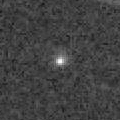
|
Now it is 16.3 mag (Oct. 3, ATLAS Chile). It stays observable at 17-18 mag until next summer. It may be brighter than this ephemeris.
Date(TT) R.A. (2000) Decl. Delta r Elong. m1 Best Time(A, h)
Oct. 8 0 35.07 -12 14.3 1.232 2.203 161 17.4 23:23 ( 0, 43)
Oct. 15 23 54.68 -13 55.0 1.228 2.148 149 17.3 22:16 ( 0, 41)
|

|
Now it is 17.8 mag (July 8, ATLAS Chile). It is expected to brighten up to 12-13 mag from 2024 to 2025.
Date(TT) R.A. (2000) Decl. Delta r Elong. m1 Best Time(A, h)
Oct. 8 10 28.05 -18 8.6 7.705 6.938 37 17.3 4:36 (295, 4)
Oct. 15 10 29.90 -18 21.0 7.601 6.894 42 17.3 4:41 (300, 9)
|
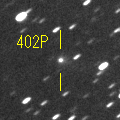
|
It brightened up to 15.3 mag in last winter (Jan. 12, H. Nohara). Now it is fading. It has already faded down to 17.7 mag (Oct. 3, Catalina Sky Survey). It will be observable at 17 mag in good condition in next winter. It locates somewhat low in the Southern Hemisphere.
Date(TT) R.A. (2000) Decl. Delta r Elong. m1 Best Time(A, h)
Oct. 8 9 42.24 18 13.3 4.811 4.281 52 17.3 4:36 (271, 34)
Oct. 15 9 48.70 18 12.2 4.737 4.296 58 17.3 4:41 (275, 40)
|

|
Now it is 17.3 mag (Oct. 4, ATLAS-MLO, Mauna Loa). It is expected to brighten up to 11-12 mag in 2024. In the Northern Hemisphere, it stays observable in good condition for a long time until 2023 autumn, although it becomes temporarily low in December. In the Southern Hemisphere, it becomes unobservable in October. But it will be observable in excellent condition at the high light.
Date(TT) R.A. (2000) Decl. Delta r Elong. m1 Best Time(A, h)
Oct. 8 17 55.94 23 8.6 5.763 5.663 79 17.3 18:58 ( 76, 59)
Oct. 15 17 55.50 22 4.1 5.799 5.611 74 17.3 18:49 ( 78, 55)
|

|
Now it is 17.2 mag (Oct. 1, D. Buczynski). It stays observable at 17-18 mag in 2022. It locates somewhat low in the Southern Hemisphere.
Date(TT) R.A. (2000) Decl. Delta r Elong. m1 Best Time(A, h)
Oct. 8 1 42.89 27 25.6 4.600 5.523 155 17.4 0:39 ( 0, 83)
Oct. 15 1 32.91 26 38.0 4.582 5.536 161 17.4 0:02 ( 0, 82)
|

|
It brightened very rapidly up to 15.5 mag from last autumn to last winter (Nov. 2, 2021, Toshihiko Ikemura, Hirohisa Sato). Now it is fading. It has already faded down to 17.3 mag (Oct. 4, W. Hasubick).
Date(TT) R.A. (2000) Decl. Delta r Elong. m1 Best Time(A, h)
Oct. 8 6 44.32 13 13.1 4.071 4.249 93 17.4 4:36 (323, 64)
Oct. 15 6 46.77 12 46.0 3.986 4.266 99 17.4 4:41 (339, 67)
|
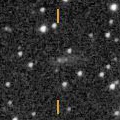
|
Now it is 17.3 mag (Sept. 30, Toshihiko Ikemura, Hirohisa Sato). In the Northern Hemisphere, it stays observable at 17 mag in good condition for a long time until winter. In the Southern Hemisphere, it stays extremely low for a long time.
Date(TT) R.A. (2000) Decl. Delta r Elong. m1 Best Time(A, h)
Oct. 8 7 27.36 46 23.7 2.680 2.831 88 17.4 4:36 (232, 67)
Oct. 15 7 38.48 46 48.4 2.620 2.847 92 17.4 4:41 (227, 70)
|

|
It approached to Sun down to 0.14 a.u. on May 15. But it was not observable around that time. In the Northern Hemisphere, it stays observable at 17-18 mag in good condition from July to November. In the Southern Hemisphere, it stays extremely low.
Date(TT) R.A. (2000) Decl. Delta r Elong. m1 Best Time(A, h)
Oct. 8 3 13.83 46 18.7 1.301 2.082 129 17.5 2:10 (180, 79)
Oct. 15 2 53.03 45 53.3 1.278 2.121 137 17.4 1:22 (180, 79)
|
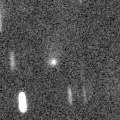
|
Now it is 17.9 mag (Oct. 4, M. Iozzi). It started fading before the perihelion passage. It was predicted to stay at 16 mag for a long time. But actually, it will be fainter than 18 mag in autumn. In the Northern Hemisphere, it stays observable in good condition for a long time. In the Southern Hemisphere, it is not observable until 2023.
Date(TT) R.A. (2000) Decl. Delta r Elong. m1 Best Time(A, h)
Oct. 8 17 43.45 50 23.8 4.011 4.022 83 17.5 18:58 (132, 60)
Oct. 15 17 49.89 47 47.7 4.066 4.044 81 17.6 18:49 (126, 59)
|
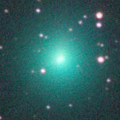
|
It brightened up to 9.3 mag from spring to early summer (Mar. 24, Michael Jager). It stayed bright for a while even after the perihelion passaage. But it is fading rapidly now. It has already faded down to 17.1 mag (Aug. 9, iTelescope Observatory, Siding Spring). However, Thomas Lehmann reported it is bright as 13.8 mag on Sept. 2. In the Southern Hemisphere, it stays observable in good condition for a long time. In the Northern Hemisphere, it will never be observable again.
Date(TT) R.A. (2000) Decl. Delta r Elong. m1 Best Time(A, h)
Oct. 8 5 34.10 -81 30.7 2.754 2.884 87 17.7 4:26 ( 0,-26)
Oct. 15 5 12.67 -83 56.2 2.882 2.964 84 18.0 3:37 ( 0,-29)
|
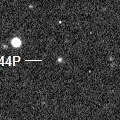
|
Now it is 18.7 mag (Oct. 5, J.-G. Bosch, F. Kugel). It is observable at 17 mag in good condition in winter. It locates somewhat low in the Southern Hemisphere.
Date(TT) R.A. (2000) Decl. Delta r Elong. m1 Best Time(A, h)
Oct. 8 6 27.12 25 43.2 3.653 3.924 98 17.8 4:36 (310, 76)
Oct. 15 6 29.88 25 45.6 3.551 3.923 104 17.7 4:41 (338, 80)
|

|
Now it is 17.5 mag (Oct. 1, Ken-ichi Kadota). In the Northern Hemisphere, it is observable at 17-18 mag in excellent condition in autumn. It is not observable in the Southern Hemisphere.
Date(TT) R.A. (2000) Decl. Delta r Elong. m1 Best Time(A, h)
Oct. 8 7 35.58 43 32.1 2.548 2.676 86 17.8 4:36 (240, 66)
Oct. 15 7 45.45 46 2.6 2.483 2.698 91 17.8 4:41 (231, 70)
|

|
Now it is 17.1 mag (Oct. 1, Toshihiko Ikemura, Hirohisa Sato). In 2022, it stays observable at 17 mag for a long time.
Date(TT) R.A. (2000) Decl. Delta r Elong. m1 Best Time(A, h)
Oct. 8 7 47.31 23 27.3 0.748 1.139 79 17.8 4:36 (284, 60)
Oct. 15 8 0.32 22 29.5 0.765 1.189 83 17.8 4:41 (291, 64)
|

|
Now it is 17.5 mag (Oct. 2, ATLAS South Africa). Very far object. It stays 18 mag for a long time from 2021 to 2026. In the Southern Hemisphere, it stays observable in good condition for a long time. In the Northern Hemisphere, it is not observable at all.
Date(TT) R.A. (2000) Decl. Delta r Elong. m1 Best Time(A, h)
Oct. 8 8 21.33 -68 27.0 10.720 10.536 76 17.9 4:36 (346,-18)
Oct. 15 8 20.95 -69 16.4 10.712 10.528 76 17.9 4:41 (349,-17)
|

|
Now it is 16.8 mag (Oct. 2, Toshihiko Ikemura, Hirohisa Sato). It was observed at 15 mag in 2021. Now it is fading. It stays observable at 16-17 mag for a while in 2022.
Date(TT) R.A. (2000) Decl. Delta r Elong. m1 Best Time(A, h)
Oct. 8 17 50.83 28 10.6 5.879 5.775 79 17.9 18:58 ( 86, 61)
Oct. 15 17 53.85 27 55.2 5.971 5.803 75 18.0 18:49 ( 88, 57)
|

|
Now it is 19.7 mag (Oct. 2, Pan-STARRS 1, Haleakala). It is observable at 17 mag in excellent condition in winter.
Date(TT) R.A. (2000) Decl. Delta r Elong. m1 Best Time(A, h)
Oct. 8 8 26.63 8 38.6 3.832 3.578 67 18.0 4:36 (295, 44)
Oct. 15 8 33.31 7 49.6 3.731 3.567 72 17.9 4:41 (302, 48)
|
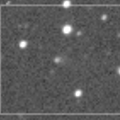
|
It was observed at 17 mag in 2021. It was expected to be observable at 17-18 mag also in 2022. But actually, it is much fainter than last year by 3 mag, 20.8 mag (Oct. 1, Pan-STARRS 2, Haleakala).
Date(TT) R.A. (2000) Decl. Delta r Elong. m1 Best Time(A, h)
Oct. 8 2 41.57 14 24.1 2.682 3.595 151 19.8 1:37 ( 0, 69)
Oct. 15 2 35.43 14 56.9 2.664 3.618 160 19.9 1:04 ( 0, 70)
|
|
![]()
 C/2020 K1 ( PanSTARRS )
C/2020 K1 ( PanSTARRS ) C/2019 U5 ( PanSTARRS )
C/2019 U5 ( PanSTARRS ) C/2022 R2 ( ATLAS )
C/2022 R2 ( ATLAS ) 29P/Schwassmann-Wachmann 1
29P/Schwassmann-Wachmann 1 C/2021 Y1 ( ATLAS )
C/2021 Y1 ( ATLAS ) 117P/Helin-Roman-Alu 1
117P/Helin-Roman-Alu 1 22P/Kopff
22P/Kopff C/2020 R7 ( ATLAS )
C/2020 R7 ( ATLAS ) 116P/Wild 4
116P/Wild 4 (65803) Didymos
(65803) Didymos C/2020 S4 ( PanSTARRS )
C/2020 S4 ( PanSTARRS ) C/2020 Y2 ( ATLAS )
C/2020 Y2 ( ATLAS ) P/2022 L3 ( ATLAS )
P/2022 L3 ( ATLAS ) C/2022 A2 ( PanSTARRS )
C/2022 A2 ( PanSTARRS ) 71P/Clark
71P/Clark 119P/Parker-Hartley
119P/Parker-Hartley 61P/Shajn-Schaldach
61P/Shajn-Schaldach C/2021 X1 ( Maury-Attard )
C/2021 X1 ( Maury-Attard ) C/2021 T4 ( Lemmon )
C/2021 T4 ( Lemmon ) 327P/Van Ness
327P/Van Ness 9P/Tempel 1
9P/Tempel 1 C/2018 U1 ( Lemmon )
C/2018 U1 ( Lemmon ) C/2021 G2 ( ATLAS )
C/2021 G2 ( ATLAS ) 408P/2020 M7 ( Novichonok-Gerke )
408P/2020 M7 ( Novichonok-Gerke ) C/2022 L1 ( Catalina )
C/2022 L1 ( Catalina ) 157P/Tritton
157P/Tritton C/2021 S3 ( PanSTARRS )
C/2021 S3 ( PanSTARRS ) 395P/2020 H1 ( Catalina-NEAT )
395P/2020 H1 ( Catalina-NEAT ) C/2020 F5 ( MASTER )
C/2020 F5 ( MASTER ) 44P/Reinmuth 2
44P/Reinmuth 2 246P/NEAT
246P/NEAT C/2019 F1 ( ATLAS-Africano )
C/2019 F1 ( ATLAS-Africano ) C/2019 T3 ( ATLAS )
C/2019 T3 ( ATLAS ) 285P/LINEAR
285P/LINEAR C/2020 H6 ( ATLAS )
C/2020 H6 ( ATLAS ) C/2019 O3 ( Palomar )
C/2019 O3 ( Palomar ) P/2022 P2 ( ZTF )
P/2022 P2 ( ZTF ) C/2022 Q2 ( ATLAS )
C/2022 Q2 ( ATLAS ) C/2022 E2 ( ATLAS )
C/2022 E2 ( ATLAS ) 402P/2020 Q3 ( LINEAR )
402P/2020 Q3 ( LINEAR ) C/2022 L2 ( ATLAS )
C/2022 L2 ( ATLAS ) C/2020 U4 ( PanSTARRS )
C/2020 U4 ( PanSTARRS ) P/2021 N2 ( Fuls )
P/2021 N2 ( Fuls ) C/2021 QM45 ( PanSTARRS )
C/2021 QM45 ( PanSTARRS ) (3200) Phaethon
(3200) Phaethon C/2020 U5 ( PanSTARRS )
C/2020 U5 ( PanSTARRS ) C/2021 F1 ( Lemmon-PanSTARRS )
C/2021 F1 ( Lemmon-PanSTARRS ) 244P/Scotti
244P/Scotti C/2022 P3 ( ZTF )
C/2022 P3 ( ZTF ) 107P/(4015) Wilson-Harrington
107P/(4015) Wilson-Harrington C/2019 E3 ( ATLAS )
C/2019 E3 ( ATLAS ) C/2020 O2 ( Amaral )
C/2020 O2 ( Amaral ) P/2021 V2 ( Fuls )
P/2021 V2 ( Fuls ) 422P/2021 L1 ( Christensen )
422P/2021 L1 ( Christensen )![]()






























































